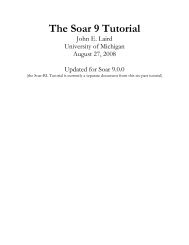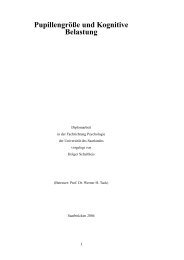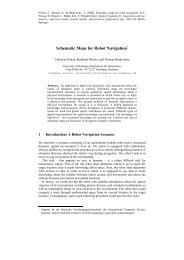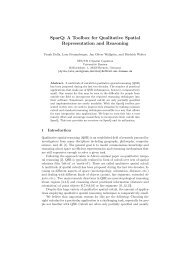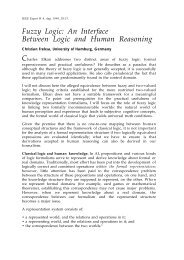Beyond Left, Right, and Straight - the Cognitive Systems Group
Beyond Left, Right, and Straight - the Cognitive Systems Group
Beyond Left, Right, and Straight - the Cognitive Systems Group
Create successful ePaper yourself
Turn your PDF publications into a flip-book with our unique Google optimized e-Paper software.
The strategies participants adopt change if <strong>the</strong> action to be instructed takes place a) at a complex<br />
intersection or b) if competing branches require a disambiguation of <strong>the</strong> situation. For <strong>the</strong><br />
identification of object locations Tenbrink (2005) provides results on how <strong>the</strong> contrast of<br />
competing objects can be enhanced. Some ideas on how contrastive reference can be achieved in<br />
route directions were presented by Klippel <strong>and</strong> Montello (2004). Besides rendering <strong>the</strong> direction<br />
concept precise, for example, by providing detailed descriptions according to <strong>the</strong> direction model,<br />
<strong>and</strong> possibly relying on clock directions or an absolute reference system, participants adopt <strong>the</strong><br />
following strategies: naming <strong>the</strong> structure in which <strong>the</strong> actions take place plus a coarse direction<br />
concept (e.g., fork right), a comparison of possibilities to take (e.g., fur<strong>the</strong>st right), a conceptual<br />
change to ordering information plus a coarse direction concept (e.g., <strong>the</strong> third to your left), <strong>the</strong><br />
description of competing directions not to take, or any combination of <strong>the</strong>se strategies. The<br />
situation changes again if l<strong>and</strong>marks are present.<br />
We analysed two corpora <strong>and</strong> will present a quantitative analysis of <strong>the</strong> strategies used. This<br />
research adds to <strong>the</strong> pending question criteria for good route directions (Dale, Geldof, & Prost,<br />
2005).<br />
References<br />
Dale, R., Geldof, S., & Prost, J.-P. (2005). Using natural language generation in automatic route description. Journal of<br />
Research <strong>and</strong> practice in Information Technology, 37(1), 89-105.<br />
Daniel, M. P., & Denis, M. (1998). Spatial descriptions as navigational aids: A cognitive analysis of route directions.<br />
Kognitionswissenschaft, 7(1), 45-52.<br />
Klippel, A. (2003). Wayfinding Choremes. In W. Kuhn, M. Worboys & S. Timpf (Eds.), Spatial Information Theory:<br />
Foundations of Geographic Information Science. Conference on Spatial Information Theory (COSIT) 2003.<br />
(pp. 320-334). Berlin: Springer.<br />
Klippel, A., & Montello, D. R. (2004). On <strong>the</strong> robustness of mental conceptualizations of turn direction concepts. In M.<br />
J. Egenhofer, C. Freksa & H. Miller (Eds.), GIScience 2004. The Thrid International Conference on<br />
Geogrpahic Information Science, October 20-23, 2004, University of Maryl<strong>and</strong> (Extended Abstract). (pp.<br />
139-141). Adelphi, Maryl<strong>and</strong>, U.S.A.: Regents of <strong>the</strong> University of California.<br />
Tenbrink, T. (2005). Identifying objects on <strong>the</strong> basis of spatial contrast: An empirical study. In C. Freksa, M. Knauff &<br />
B. Krieg-Brueckner (Eds.), Spatial Cognition IV. Reasoning, Action, <strong>and</strong> Interaction: International<br />
Conference Spatial Cognition 2004, Frauenchiemsee, Germany, October 11-13, 2004, Revised Selected<br />
Papers (Vol. Lecture Notes in Computer Science, Volume 3343, pp. 124-146). Berlin: Springer.



